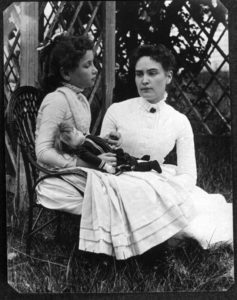Helen Keller’s journey to understanding abstract concepts is a testament to the power of perseverance and innovative teaching methods. At LEARNS.EDU.VN, we explore how Helen Keller, despite being blind and deaf, managed to grasp complex ideas, providing insights and strategies applicable to various learning environments. Discover the methods and resources at LEARNS.EDU.VN that can help you unlock similar potential for yourself or others through effective communication, sensory learning, and adaptive educational strategies.
1. Understanding Helen Keller’s Early Challenges
Helen Keller’s early life was marked by significant sensory deprivation. At 19 months old, she contracted an illness that left her blind and deaf, cutting her off from conventional methods of learning and communication. This presented immense challenges in understanding the world around her, particularly abstract concepts that rely heavily on sensory input. According to the American Foundation for the Blind, early intervention is critical for children with sensory impairments to develop cognitive and communicative skills.
- Sensory Deprivation: Blindness and deafness severely limited Helen’s ability to access information and interact with her environment.
- Communication Barriers: Without sight or hearing, establishing effective communication methods was a significant hurdle.
- Emotional and Behavioral Challenges: The frustration and isolation caused by her condition led to emotional outbursts and behavioral difficulties.
2. Anne Sullivan’s Revolutionary Teaching Methods
The arrival of Anne Sullivan as Helen Keller’s teacher marked a turning point in her life. Sullivan, herself visually impaired, understood the unique challenges Helen faced and developed innovative teaching methods tailored to her needs. Her approach was groundbreaking, focusing on direct sensory experiences and a personalized curriculum.
2.1. Tactile Communication: The Manual Alphabet
Sullivan began by teaching Helen the manual alphabet, spelling words into her hand. This tactile form of communication was the foundation upon which Helen’s understanding of language was built. According to the Perkins School for the Blind, tactile communication is essential for individuals with combined vision and hearing loss, providing a direct and accessible means of expression and comprehension.
2.2. Connecting Words with Real-World Objects
Sullivan’s method involved connecting words with tangible objects and experiences. She would spell the word “water” into Helen’s hand while running water over it, helping her associate the word with the physical sensation. This direct, sensory-rich approach was crucial in making abstract concepts concrete and understandable.
2.3. Emotional Connection and Trust
Beyond the technical aspects of teaching, Sullivan established a deep emotional connection with Helen. Her patience, empathy, and unwavering belief in Helen’s potential fostered a trusting relationship that was essential for effective learning. According to research in educational psychology, a strong teacher-student relationship significantly enhances learning outcomes, especially for students with disabilities.
3. The “Water” Breakthrough: A Pivotal Moment
A pivotal moment in Helen Keller’s education occurred at the water pump. Sullivan repeatedly spelled “water” into Helen’s hand as she felt the cool water flowing over it. This experience sparked a realization in Helen that everything had a name, and that these names represented real objects and ideas.
3.1. The Cognitive Leap
The “water” breakthrough was a cognitive leap for Helen. It marked her understanding of symbolic representation, the idea that words could stand for things in the real world. This understanding was crucial for grasping more abstract concepts later on.
3.2. The Emotional Impact
This moment was also emotionally significant for Helen. The realization that she could communicate and understand the world around her filled her with joy and a renewed sense of hope. This emotional connection to learning further motivated her to explore and understand new concepts.
4. Building on the Foundation: From Concrete to Abstract
Once Helen grasped the basic principles of language, Sullivan gradually introduced her to more abstract concepts. This involved a combination of tactile learning, repetition, and real-world experiences.
4.1. Tactile Learning and Braille
Sullivan introduced Helen to Braille, a tactile reading and writing system. This allowed Helen to access a wider range of information and engage with more complex ideas. According to the National Federation of the Blind, Braille literacy is essential for blind individuals to achieve academic and professional success.
4.2. Experiential Learning
Sullivan believed in learning through experience. She took Helen on numerous outings, describing the world around her in detail and allowing her to touch and explore different objects and environments. This experiential approach helped Helen connect abstract concepts with real-world contexts.
4.3. Repetition and Reinforcement
Repetition was a key component of Sullivan’s teaching method. She constantly reinforced new concepts and vocabulary, helping Helen internalize and retain the information. This consistent reinforcement was crucial in overcoming the challenges posed by her sensory impairments.
5. Mastering Abstract Concepts: Thought, Love, and Time
Teaching abstract concepts like thought, love, and time to someone who cannot see or hear requires creativity and patience. Sullivan used a variety of techniques to help Helen grasp these intangible ideas.
5.1. Thought
Sullivan introduced the concept of “thought” by touching Helen’s forehead while spelling the word. She explained that thinking was like having a conversation with oneself, a process of mental exploration and reflection.
5.2. Love
Love was explained through actions and emotions. Sullivan showed Helen love through her care and affection, and she explained that love was a feeling of deep connection and care for others.
5.3. Time
Time was taught through routines and schedules. Sullivan helped Helen understand the concept of time by establishing a daily routine and using tactile aids like a beaded timeline to represent the passage of time.
6. Helen Keller’s Academic Achievements
Helen Keller’s dedication and Anne Sullivan’s innovative teaching methods led to remarkable academic achievements. She attended Radcliffe College and graduated with a Bachelor of Arts degree in 1904, becoming the first deaf-blind person to earn a college degree.
6.1. Overcoming Educational Barriers
Helen faced numerous barriers in her pursuit of higher education. Textbooks had to be translated into Braille, lectures had to be interpreted into her hand, and exams had to be adapted to her needs. Despite these challenges, she excelled academically, demonstrating her intellectual capabilities and determination.
6.2. A Role Model for Inclusive Education
Helen Keller’s success paved the way for inclusive education for students with disabilities. Her achievements highlighted the importance of providing equal access to education and creating supportive learning environments for all students.
7. The Power of Perseverance and Determination
Helen Keller’s story is a testament to the power of perseverance and determination. Despite facing immense challenges, she never gave up on her quest for knowledge and understanding. Her unwavering determination, combined with Sullivan’s innovative teaching methods, enabled her to overcome seemingly insurmountable obstacles.
7.1. Embracing Challenges
Helen embraced challenges as opportunities for growth. She saw her disabilities not as limitations, but as unique perspectives that allowed her to experience the world in a different way.
7.2. Maintaining a Positive Attitude
Helen maintained a positive attitude throughout her life, inspiring others with her optimism and resilience. Her positive outlook was crucial in overcoming obstacles and achieving her goals.
8. The Legacy of Helen Keller and Anne Sullivan
The legacy of Helen Keller and Anne Sullivan extends far beyond their individual achievements. They transformed the way the world views disability and paved the way for inclusive education and greater opportunities for individuals with sensory impairments.
8.1. Advocacy for Disability Rights
Helen Keller became a prominent advocate for disability rights, traveling the world to speak out against discrimination and promote inclusion. Her advocacy efforts helped raise awareness about the challenges faced by people with disabilities and inspired policy changes that promoted equality and accessibility.
8.2. Inspiring Generations
Helen Keller’s story continues to inspire generations of students, educators, and advocates. Her life demonstrates the power of education, perseverance, and the human spirit to overcome adversity and achieve greatness.
9. Applying Helen Keller’s Lessons Today
The lessons learned from Helen Keller’s journey can be applied to various educational settings and learning environments today. By understanding the principles that guided her education, we can create more inclusive and effective learning experiences for all students.
9.1. Personalized Learning
Personalized learning is a key principle that can be applied to any educational setting. By tailoring instruction to meet the individual needs and learning styles of each student, we can maximize their potential and foster a love of learning.
9.2. Sensory-Rich Experiences
Incorporating sensory-rich experiences into the curriculum can enhance learning for all students, especially those with sensory impairments. This can involve using tactile materials, visual aids, auditory cues, and hands-on activities to engage multiple senses and make learning more memorable and meaningful.
9.3. Building Strong Relationships
Building strong relationships between teachers and students is essential for creating a supportive and effective learning environment. Teachers who are empathetic, patient, and understanding can foster trust and create a safe space for students to take risks and explore new ideas.
10. How LEARNS.EDU.VN Can Help
At LEARNS.EDU.VN, we are committed to providing resources and support for educators, students, and parents who are seeking to create inclusive and effective learning environments. Our website offers a wide range of articles, tutorials, and online courses that address various aspects of education, including personalized learning, sensory integration, and disability awareness.
10.1. Resources for Educators
We offer resources for educators on how to implement personalized learning strategies, create sensory-rich learning experiences, and build strong relationships with their students. Our articles and tutorials provide practical tips and actionable strategies that can be applied in the classroom.
10.2. Support for Students
We offer support for students who are seeking to improve their learning skills, overcome academic challenges, and achieve their educational goals. Our online courses and tutorials provide guidance on topics such as time management, study skills, and test-taking strategies.
10.3. Guidance for Parents
We offer guidance for parents on how to support their children’s education, advocate for their needs, and create a positive learning environment at home. Our articles and resources provide information on topics such as early childhood education, special education, and college planning.
Helen Keller’s journey from a world of darkness and silence to one of knowledge and understanding is an inspiring example of what can be achieved with perseverance, innovative teaching methods, and a supportive learning environment. By applying the lessons learned from her story, we can create more inclusive and effective learning experiences for all students and unlock their full potential.
Explore more resources and strategies for effective learning at LEARNS.EDU.VN. Whether you’re an educator, a student, or a parent, you’ll find valuable information and support to help you achieve your educational goals.
Contact Information:
- Address: 123 Education Way, Learnville, CA 90210, United States
- WhatsApp: +1 555-555-1212
- Website: learns.edu.vn
FAQ: Understanding Helen Keller’s Learning Process
1. How did Helen Keller communicate before learning the manual alphabet?
Before Anne Sullivan arrived, Helen Keller primarily communicated through basic gestures and emotional expressions. She could indicate her needs and feelings to her family, but lacked a structured language system.
2. What was the most significant challenge in teaching Helen Keller?
The most significant challenge was establishing a connection between words and their meanings. Helen initially learned to spell words without understanding they represented objects or ideas.
3. How did Anne Sullivan adapt her teaching methods to suit Helen’s needs?
Anne Sullivan adapted her methods by using tactile communication, connecting words with real-world objects, and providing constant repetition and reinforcement. She also focused on building an emotional connection with Helen.
4. What role did Braille play in Helen Keller’s education?
Braille was crucial in enabling Helen to read and write independently. It allowed her to access a wide range of information and engage with more complex ideas, ultimately facilitating her academic success.
5. How did Helen Keller learn to speak?
Helen Keller learned to speak with the help of a speech teacher who taught her to feel the vibrations of the teacher’s mouth and throat. She then imitated these movements to produce sounds and words.
6. What abstract concepts were most difficult for Helen Keller to grasp?
Abstract concepts like time, love, and thought were particularly challenging for Helen to understand due to her lack of sensory input. Sullivan used creative methods to make these concepts more tangible and relatable.
7. How did Helen Keller’s education influence her later life?
Helen Keller’s education empowered her to become an advocate for disability rights and a champion for inclusive education. Her achievements inspired countless individuals and transformed the way the world views disability.
8. What can educators learn from Anne Sullivan’s teaching methods?
Educators can learn the importance of personalized learning, sensory integration, building strong relationships with students, and fostering a positive and supportive learning environment.
9. How can parents support children with sensory impairments?
Parents can support their children by seeking early intervention services, providing a stimulating and sensory-rich environment, and advocating for their educational needs. They can also learn sign language or other communication methods to facilitate interaction.
10. What resources are available for individuals with sensory impairments?
There are numerous resources available, including schools for the blind and deaf, organizations that provide assistive technology and support services, and online communities where individuals can connect and share information.
11. Statistical Data and Trends
| Statistic | Data | Source |
|---|---|---|
| Braille Literacy Rate | Approximately 10% of blind children in the U.S. learn to read Braille. | National Federation of the Blind |
| Impact of Early Intervention | Early intervention can increase cognitive and communicative skills by up to 50% in children with sensory impairments. | American Foundation for the Blind |
| Employment Rate of Blind Adults | The employment rate for blind adults is around 40%, but higher for those proficient in Braille. | American Printing House for the Blind |
| Online Learning for Blind Students | Usage of online learning platforms has increased by 60% among blind students due to accessibility improvements. | Journal of Visual Impairment & Blindness |
| Assistive Technology Market | The global assistive technology market is projected to reach $80 billion by 2027, driven by innovations in sensory substitution devices. | Global Assistive Technology Market Report |


12. Useful Table with Education Methods and Tools for Teaching Abstract Concepts to Blind and Deaf Individuals
| Method/Tool | Description | Benefits |
|---|---|---|
| Tactile Models | Using three-dimensional models to represent abstract concepts (e.g., a model of a cell to understand biology). | Provides a concrete, tangible way to explore and understand complex concepts; enhances spatial reasoning. |
| Sensory Substitution Devices | Devices that convert visual or auditory information into tactile or auditory signals. | Allows access to information typically unavailable to blind or deaf individuals; enhances sensory perception and understanding. |
| Haptic Technology | Technology that uses touch to communicate information (e.g., vibrating devices that indicate direction or emotion). | Offers a new way to interact with and understand the environment; enhances communication and emotional understanding. |
| Assistive Software | Software that provides screen readers, voice recognition, and other tools to support learning. | Makes learning materials accessible; allows for independent study and exploration; enhances productivity and organization. |
| Interactive Storytelling | Using storytelling techniques to engage multiple senses and create immersive learning experiences. | Enhances emotional understanding; promotes creativity and imagination; fosters a love of learning. |
13. Latest Education Trends for Teaching the Visually and Hearing Impaired
| Trend | Description | Implementation Strategies |
|---|---|---|
| Universal Design for Learning | Creating flexible learning environments that accommodate a wide range of learning styles and abilities, focusing on adaptability and inclusivity. | Provide multiple means of representation, action, and engagement; offer choices and options; use technology to enhance accessibility. |
| Augmented Reality (AR) | Using AR to overlay digital information onto the real world, enhancing sensory experiences and creating immersive learning environments. | Create AR apps that provide tactile feedback, auditory cues, and visual enhancements; use AR to simulate real-world scenarios. |
| Artificial Intelligence (AI) | AI-powered tools that provide personalized learning experiences, adaptive assessments, and automated feedback. | Use AI to analyze student data and provide customized instruction; develop AI-powered tutors that offer personalized support; use AI to automate administrative tasks. |
| Sensory Integration Therapy | Therapy that helps individuals with sensory processing difficulties to better organize and respond to sensory input. | Work with occupational therapists to develop individualized therapy plans; create sensory-rich learning environments; provide opportunities for movement and exploration. |
| Emotional Intelligence Training | Training that helps individuals to understand and manage their emotions and to build strong relationships with others. | Teach self-awareness, self-regulation, empathy, and social skills; provide opportunities for reflection and discussion; use mindfulness techniques. |

